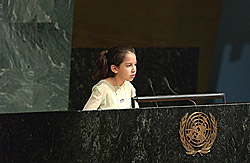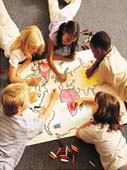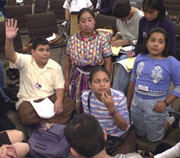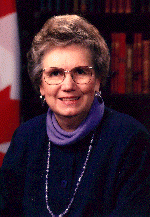Common menu bar links
Institutional links
Diseases & Conditions
Health & Safety
Research & Statistics
Agency Information
Search Box
National Plan of Action for Children
E-mail this page
National Plan of Action for Children
History

United Nations General Assembly on Children
In May 2002, Canada participated in the United Nations General Assembly Special Session on Children. During the Special Session, world leaders and thousands of delegates, including children, reviewed progress and lessons learned since the 1990 World Summit for Children. They also renewed the international agenda for children for the coming decade (2002 - 2012). Their commitments are contained in the consensus document entitled A World Fit for Children.
Consisting of a Declaration and Plan of Action, A World Fit for Children outlines and renews global commitments to and future actions for children (0 to 18 years). The Plan of Action addresses four major areas: 1) promoting healthy lives; 2) providing quality education; 3) protecting against abuse, exploitation and violence; and 4) combating HIV/AIDS. It presents how to create a world fit for children through specific goals, strategies and actions; mobilizing resources; and follow-up actions and assessment.

Gabriella Asurduy Arrieta, 13, from Bolivia, was one of the Children's Forum delegates who presented the recommendations of the Forum to the United Nations General Assembly on Children.
A World Fit for Children includes a section called A World Fit for Us, which is the statement made by children at the Special Session. In their own words, boys and girls from virtually every country set out their priorities. They call for people to respect, protect and promote their rights. Peace-building, health care, the eradication of poverty, quality education, and the protection of the environment are also necessary to ensure their well-being.
A World Fit for Children contains a global plan of action that describes what the nations of the world must do for and with children. In it, individual nations are called upon to develop their own action plans in order to facilitate the commitments made in A World Fit for Children. Progress in implementing the global plan of action will be carefully monitored and detailed in reports by countries to the United Nations in 2006, 2011, and 2016.
Since the Special
Session, the Prime Minister of Canada has asked the Honourable Anne
McLellan, Minister of Health, and the Honourable Jane Stewart,
Minister of Human Resources Development Canada (HRDC), to develop
Canada's National Plan of Action (NPA), and the Honourable
Landon Pearson "the children's Senator" to act as his
personal representative to this process.

In order for Canada to achieve the goals set out in A World Fit for Children, Canadians of all ages must work together to prepare an NPA that is child-centred, forward-looking, multi-sectoral and respectful not only of our cultural diversity but also of our constitution.
Developing Canada's National Plan of Action for children
The Canadian government is moving forward in the development of the NPA on behalf of Canadians. To develop a meaningful NPA it is essential that as many interested Canadians as possible have their voices heard. Already, Senator Pearson, Health Canada and HRDC have begun listening to and working with Canadians.
Guided by the United Nations Convention on the Rights of the Child, the NPA should build on the solid foundation of Canada's current and past commitments to children, both at home and abroad. Canada's NPA will highlight emerging issues and look forward to the future. Canadians of all ages now have the opportunity to work together and to protect and promote children's rights while discussing and building Canada's vision for children for the coming decade.
Based both on what Canadians have been saying and also on Canada's domestic and international commitments to children ? specifically on the themes of A World Fit for Children, the visions of the National Children's Agenda, and the principles of the United Nations Convention of the Rights of the Child ? Canada's NPA is currently focusing on four themes.
- Promoting healthy lives, including combating HIV/AIDS
- Providing quality education
- Protecting against abuse, exploitation, violence and neglect
- Enabling social engagement and collaboration
Engaging Canadians
The development of Canada's NPA allows for a wide range of opinions, thoughts and ideas to be shared. Only as a result of the extensive involvement of Canadians can we create a Canada and a world fit for children.
Overall, the principles of the best interests of the child, non-discrimination, participation and survival and development provide the framework for Canada's actions concerning children. Consistent with lessons learned during the previous decade, the goals of Canada's consultative process are:
- To set priorities and determine emerging issues and opportunities for action;
- To identify institutional mechanisms for the promotion of the rights of the child, including greater public awareness of the United Nations Convention on the Rights of the Child;
- To identify mechanisms for monitoring progress and reassessing priorities;
- To identify ways of mobilizing new and existing resources to ensure that the rights of each and every child in Canada and abroad are promoted and respected; and
- To establish a model for future involvement in policy development processes for children that is child-centred, multi-sectoral, forward-looking and collaborative
Children's Participation

Youth representatives at the United Nations Special Session on Children, 2002
Children are participating in the development of Canada's NPA. At the Special Session on Children, governments were urged to involve children in the planning, implementing and monitoring stages. So far, young people have been working closely in Canada's process to make sure that their voices are heard. Their participation in every stage of this process is essential.
Planning for the involvement of young people is on-going and accomplished in partnership with the Child Engagement Experts Resource Team (CEERT), a group of children and adults. Consideration has been given to develop a process and approach to consulting with stakeholders that allows young participants to fully participate in the development of Canada's NPA.
How Canadians are Being Heard
Canadians of all ages were engaged in a variety of ways. Consultation activities were carried out by Honourable Senator Landon Pearson, the co-lead federal departments (Health Canada and HRDC), and representatives of civil society as members of Steering and Consultative committees.
Letters to Senator Pearson
The process of developing Canada's NPA started in December 2002, when

Senator Landon Pearson invited initial input from a wide range of Canadians, including children, young people and adults, as well as non-governmental organizations and the private sector. Senator Pearson invited Canadians to write her a letter describing priorities for action on behalf of children, strategies for getting there, and emerging issues of concern ? in other words, what a Canada and a world fit for children should look like. The letters received reflect the diverse realities of Canadian children and have given voice to hundreds of organizations and individuals. Quality education; improved health care; the eradication of poverty; Aboriginal children; children with disabilities; early childhood care and development; children's participation; child protection issues; a clean environment, and parental supports all ranked high.
Regional Dialogues

The Dialogues were two day-long, facilitated discussions that gave participants the chance to share their knowledge, experience, and interest in children's issues. They were designed to bring regional and/or national perspectives and encourage a holistic approach by involving a cross-section of Canadian society. Dialogues were held in western (including BC, AB, YK), prairie (including SK, MB, NWT), central (including ON, NT, QC), and eastern (including NB, PEI, NS, NF/LB) Canada. These dialogues were hosted by the Honourable Landon Pearson and the Honourable Ethel Blondin-Andrew, Secretary of State (Children and Youth). A Discussion Guide was developed in order to enrich the Dialogues.
Partner Events
In addition to the Dialogues and the hundreds of letters that were received, interested Canadians provided input by hosting partner events. Partner events took advantage of existing conferences, meetings or mailings to seek input on the NPA. Groups were encouraged to use the same questions for discussion as used in the regional Dialogues. A Partner Event Guide was developed to be used in conjunction with the Discussion Guide. In this way, community groups, NGOs, schools, and other interested citizens were encouraged to provide information on, and support for, the NPA.
Government of Canada Involvement
Federal departments incorporated discussions of the NPA in relevant consultation activities with stakeholders or within their departments, and have otherwise contributed to the development of Canada's NPA. Senator Pearson also wrote to premiers and territorial leaders to invite them to participate in the development of the NPA.
Next Steps

The process of developing Canada's NPA for children has already started. This process has been designed to identify the views and priorities of a wide cross-section of Canadians, including young people. Canadians bring a wealth of knowledge and experience to the development of Canada's NPA. Already, we have heard from many organizations and individuals who have written to us to identify their views and share their ideas. By contributing their unique perspectives, Canadians are helping to shape Canada's National Plan of Action for children, ensuring that it represents the views of all Canadians. After all, only together can we create a Canada and a world fit for children.
